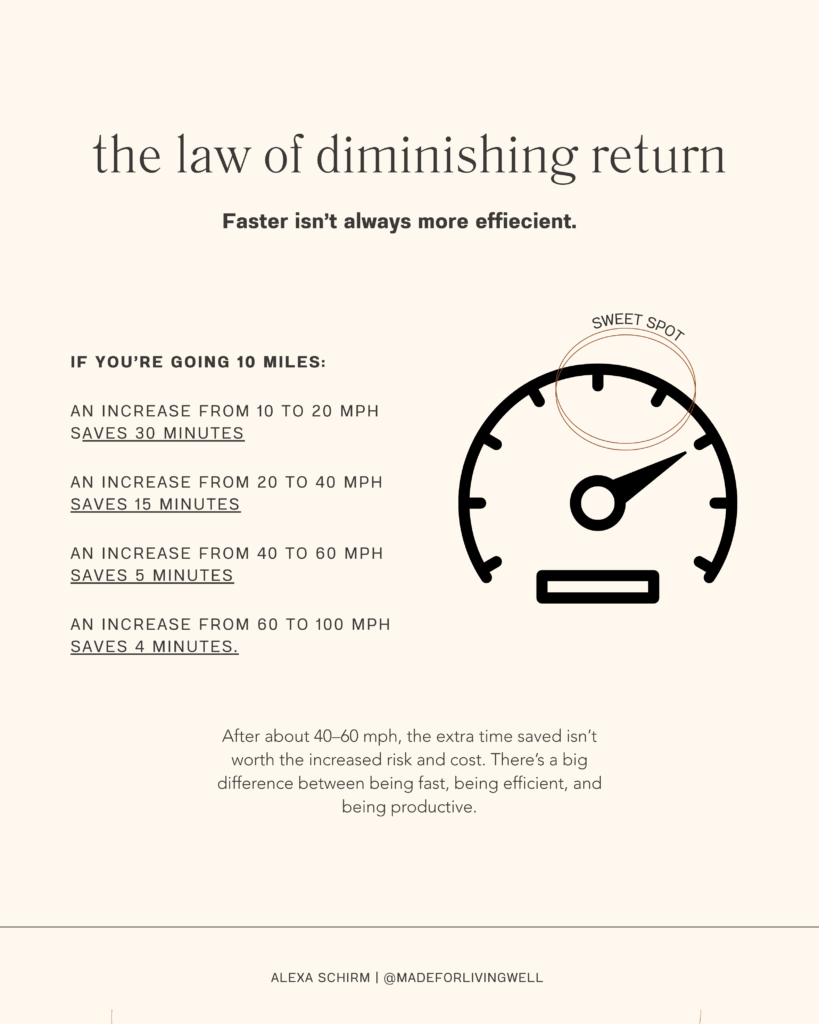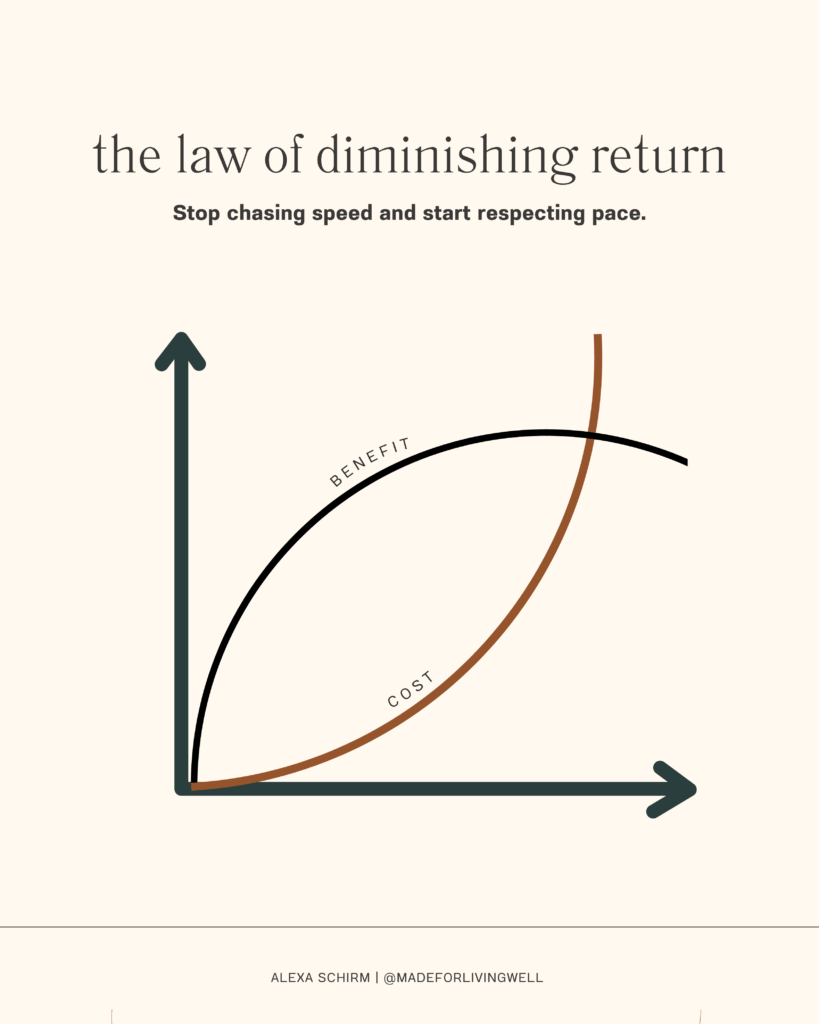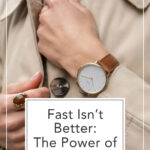
Slowing down in a world that tells you to speed up is not the easiest thing to do, but it is one of the most powerful. It may feel contradictory to think that results and outcomes can happen faster by working more slowly. Yet, in our current culture, fast equates to success, and slow is often perceived as failure. Unfortunately, this mindset has trained us to fear slowness and to rush regardless of the cost.
But I need to clarify, slow doesn’t mean what most people think. It’s not a lack of ambition, laziness, or falling behind. Slow is actually more about precision, intentionality, and alignment. It’s about honoring your rhythm and letting growth happen at a sustainable pace.
Today, I want to help you understand the paradox of slow and why honoring such a pace can change your outcomes and, more importantly, the way you live life.
Redefining slow
Slow actually means: moving at a sustainable, embodied pace that keeps you inside your zone of highest returns.
Rather than being defined as lazy and unmoving. It’s actually:
- Moving but not stagnant.
- Deeply aware rather than reactive.
- Aligned with the body’s rhythm, nervous system capacity, and long-term trajectory.
Slow is a pace that protects momentum rather than sacrificing, preventing burnout and chronic dissatisfaction. It ensures that your effort compounds, rather than being wasted because you’re chasing speed.
So let me be clear. Slow is not the absence of motion. It’s moving at the right speed and depth to ensure motion is compounding. It’s a speed that creates the greatest and easiest outcomes.
The Power of Slow in Health
In the scope of health, health isn’t about how fast you can change your behavior. It’s about how deeply your body and mind can absorb the change so it becomes part of your nature.
Of course, destination thinking, such as viewing health as a place you arrive, often leads you to chase speed as if a faster detox or quicker weight loss can fix your problem. But the body doesn’t heal based on speed or your timeline of urgency. It heals on its own timeline, through rhythm, consistency, and integration.
The paradox of slow is easier to understand when you consider the law of diminishing returns. This principle explains what happens when you keep adding effort. It states that beyond a certain point, each additional input produces less benefit than before.
It’s the idea that success is not about chasing, rushing, or working faster. Or, on the other extreme, stopping altogether. It’s about balance. It’s not about more or less but about balance or alignment.
The key is finding your optimal zone, where effort creates maximum return. Your body, your energy, and every system inside you operate by this law.
The Law of Diminishing Returns at Work
One of the best examples of the law of diminishing returns at work is your speed over time.
Imagine your health journey like a 100-mile road trip. The speed at which you move changes the trajectory of when you arrive. However, faster does not always mean less time. At a certain point, the law of diminishing returns kicks in, and your effort overrides your outcomes.
For example:
If you start your journey at a slow pace, say 10 mph, it would take 10 hours to reach your destination. However, if you speed up to 20 mph, suddenly the trip takes 5 hours. That’s a huge 5-hour time savings for doubling your speed. The difference is massive, and your effort is clearly paying off.

However, higher speeds do not offer the same results.
If you were traveling at 100 mph, the same 100-mile trip would take 1 hour. However, if you increase your pace at the same rate of 10 mph, pushing it to 110 mph, you only end up saving 5.5 minutes. That’s a tiny gain for a lot more stress and risk.
This is an example of the law of diminishing returns at work. Big gains happen when you move from slow to moderate speed. But small gains at high speed are costly. The returns shrink, while the dangers and costs rise.
The ideal pace—the sweet spot—is finding your optimal pace.
Using The Power of Slow In Your Life
Let’s make it more practical for your health strategy. For instance, say you want to create a health outcome.
If you start slowly, say by walking for 10 minutes a day, drinking one extra glass of water, or adding a single nourishing habit. For your body, it’s like moving from 10 mph to 20 mph. Your progress doubles, energy rises, and the payoff is huge.
As you continue to move, you build momentum. The 10-minute walk turns into a 30-minute walk, while you begin eating mostly whole foods and sleeping consistently. This is your sweet spot, your optimal cruising speed. The place where your effort matches return. Your body absorbs change, your nervous system thrives, and you feel whole.
However, if you attempt to push that, speeding up even just a bit more, such as tracking every bite of food, obsessing about your health, or doing two-hour workouts, it’s like driving 100 mph instead of 60. You think you’ll arrive faster, but the time saved is minimal. Meanwhile, the stress, risk, and exhaustion increase. Your body resists, energy dips, and joy disappears.

This is the law of diminishing returns in motion: pushing past your body’s optimal pace gives almost no real benefit, yet costs you everything.
The big lesson: Big gains come from moving from slow to moderate speed.
The faster you push past your optimal pace, the less real progress you make and the more energy you drain.
Pay attention to your speed. Are you moving faster than you should? The answer probably lies in how you feel – are your health practices and changes fueling your body battery or draining it?
The body doesn’t reward speed — it rewards safety, rhythm, and consistency.
When health is approached slowly, each action compounds into a new baseline. You’re not starting over every Monday because the changes have actually become part of your inner rhythm and routine.
Remind yourself, health isn’t a race. If you go too slow, you never leave the driveway. But, if you go too fast, you’ll crash before reaching your outcome. The key is to create a steady and sustainable pace, establishing habits that you can absorb, rhythms your body can integrate, and growth that compounds over time.
Slowness is not the absence of motion. It’s motion, plus presence, plus integration.
